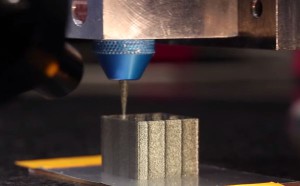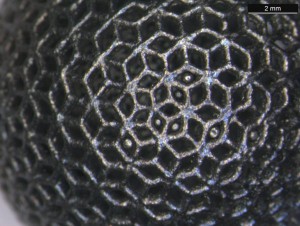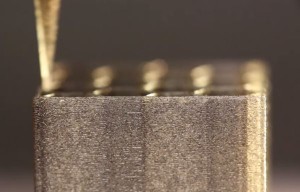One of the most appealing and advantageously exploitable aspects of 3D printing is the possibility of creating parts composed by reticular structures that improve their mechanical features and at the same time reduce their weight. The sectors where we can apply this concept are manifold, also thanks to the possible scalability we can range from the automotive and aerospace sectors to nano-manufacturing and biotechnology.
 The research in the field of the production of reticular structures thanks to 3D printing is in ferment: various institutes and universities, mainly American, are carrying out studies and projects with exciting results, even if they will find commercial outlets only in the medium-long term.
The research in the field of the production of reticular structures thanks to 3D printing is in ferment: various institutes and universities, mainly American, are carrying out studies and projects with exciting results, even if they will find commercial outlets only in the medium-long term.
Pittsburgh University, for instance, is collaborating with specialized companies (in detail “Acutec Precision Machining Inc.”, “Alcoa Inc.”, “ANSYS Inc.” and “ExOne”) for the development of a project aimed at compiling software permitting the topologic optimization of elements, precisely through the creation of reticules, with FEA approval. The technologies used for the research are the following: DMLS (direct metal laser sintering), LENS (laser engineered net shaping) and stereo-lithography; the examined materials include various metal alloys (including Ti-6Al-4V) and some plastics, like ABS.
The additive manufacturing is the only possible technology able to generate such structures, dividing the parts and producing them layer by layer, it allows achieving very complex geometrical shapes like cellular structures. The project in course sets the target of minimizing the weight of the parts examined in relation to a given load to be borne, satisfying the admissible requisites of stress and load imposed. The analysis for the topologic optimization considers the stresses on a geometry and removes the material in excess, to repeat then the test. The instruments for the topologic optimization are developed according to micro-engineering models together with finite element analysis.
The results of the study can find applications in sectors where they pursue the highest optimization of components to decrease the weight, while maintaining the structural stability, like the aerospace industry. Researchers anyway foresee that the computational technology for the optimization of cellular structures to be 3D-printed will be marketed and applied also to the design of parts and components, with concrete applications on a broad scale, from architecture to micro-engineering.
 Likewise, researchers of the “Center for Bits and Atoms” of MIT have developed a reticular structure 10 times stiffer for a given weight than any other ultralight material. The structure is modular and can be easily assembled and disassembled; besides, when it can no longer bear the imposed load, it collapses in incremental way, thus improving its reliability and, being modular, it is possible to replace simply the damaged module.
Likewise, researchers of the “Center for Bits and Atoms” of MIT have developed a reticular structure 10 times stiffer for a given weight than any other ultralight material. The structure is modular and can be easily assembled and disassembled; besides, when it can no longer bear the imposed load, it collapses in incremental way, thus improving its reliability and, being modular, it is possible to replace simply the damaged module.
The inspiration of the structure design comes from the crystalline orthorhombic structure of the perovskite, mineral contained in the earth’s crust.
In this case, too, the reference sector for its applicability is aerospace, of which it could potentially revolutionize the manufacturing costs because it would be no more necessary to manufacture enormous components in a single piece, as traditionally done with composite materials, staking instead on the flexibility and the modularity of the parts to be assembled.
The biologic inspiration is at the base also of a study, fruit of the collaboration between SEAS (Harward School of Engineering and Applied Sciences) and the Wyss Institute, aimed at processing honeycomb structures made of epoxy resin and carbon fibre that imitate the performances of balsa.
In this case, the reference application are precisely the blades of wind generators that traditionally contain a balsa core in their inside. Like many other products that are composed by a sandwich of materials to match lightness and stiffness at best, wind blades contain strips of balsa wood coming from Ecuador, which satisfies 95% of the world demand.
The Balsa wood has been appreciated for centuries for its lightness and rigidity/low density ratio; on the other hand, anyway, it is expensive and small natural variations in the grains can affect the performance of the wind blade or of other sophisticated applications.
 While the producers of turbines more and more increase blade sizes (the longest currently measures 75 metres), at the same time they must grant that components do not need maintenance for decades. To satisfy more and more exacting demands concerning precision, weight and overall dimensions, producers are researching alternatives to the present construction materials.
While the producers of turbines more and more increase blade sizes (the longest currently measures 75 metres), at the same time they must grant that components do not need maintenance for decades. To satisfy more and more exacting demands concerning precision, weight and overall dimensions, producers are researching alternatives to the present construction materials.
In this ambit, operate the researchers of Harward and of the Wyss Institute who have developed a composite material made of epoxy resin reinforced by carbon fibres coupled with a 3D extrusion technique to produce cellular structures with a notable weight/rigidity ratio. Thanks to its mechanical properties and the control of the manufacturing scale, researchers affirm that the new material imitates and improves the structure and the characteristics of balsa and of the best polymeric compounds currently available on the market.
Until now, the 3D printing has been optimized for thermoplastic UV ray-sensitive resins, materials typically unsuitable for structural applications, but treating a new class of materials, like epoxides, opens new possibilities for structural applications. Balsa has a cellular structure that reduces its overall weight, since the majority of the space is hollow, only the cell walls bear loads: researchers have replicated their geometry by using advanced materials.
The tests carried out have demonstrated that the cellular composites obtained are as stiff as the wood, from 10 to 20 times stiffer than 3D printed polymers and the double of the best printed polymer-based composite. The more we succeed in controlling the fibre orientation as to the shape and the efforts that the part to be produced must bear, the more we can optimize weight and design, while increasing efficiency.
The relationship between engineering and nature, the biomimetics, can suggest winning solutions and the additive manufacturing can offer the suitable instruments for replicating them faithfully, avoiding the limits imposed by conventional production techniques. Operational advantages are remarkable, the only unknown is to know how much time will pass for the decrease of production costs, to see applications of these projects in commercial works.


